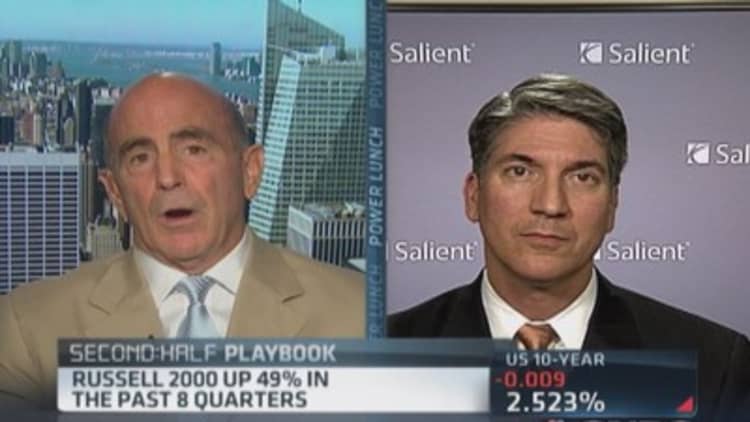Investor expectations are growing for the second half of 2014, with consensus belief that the thus-far weak economy will turn around and the raging bull market is not yet out of steam.
We'll soon find out if those high hopes are justified.
Company earnings reports start up in earnest in another week or so, with Wall Street expecting the to show gains of 6.7 percent in bottom-line profit (down from 10.3 percent in January) and 2.8 percent in revenue, according to S&P Capital IQ.
Once things get going, the Street will be watching not so much the backward-looking profit numbers but rather forward-looking statements. Specifically, the focus should be on three things: whether companies will continue share repurchases; the level of planned investment through capital expenditures; and how confident companies are with future growth.
Buybacks: Go big or go home?
Share buybacks were huge in the first quarter, rising about 60 percent to $160 billion, and that helped put a floor under the S&P 500 stock market index, which gained barely 2 percent.
Read MoreHowto play stocks in the second half of 2014
The second quarter was considerably better for the market, pushing the year-to-date gain to 6.8 percent, but there's worry that companies—awash in both cash and debt—may become reticent to keep pumping up their own shares. Market data firm TrimTabs, in fact, said buybacks slowed considerably in the second quarter, to $92.7 billion, a number that would be the lowest in seven quarters.
Jim Brown at Option Investor shared these thoughts in his weekend report:
Here is the $64k question. Did they stop the buybacks because they ran out of money or because they expect to buy the stocks back cheaper in the future? I would vote for a combination of the two. With the markets at new highs stocks are not cheap. That means you can buy back less and your money does not go as far. Also, with stocks at new highs going into summer there is always the potential for a correction.
Lastly, since we know Q1 was a weak quarter for sales and profits and Q2 may not be much better there is the possibility companies have elected to save cash to get them over the next soft patch as we head into the midterm election weakness.
In its Buttonwood column, The Economist commented further:
Another factor propping up the stock market has been the repurchase of shares. In America companies have been buying back their shares at an annualised rate of $400 billion, or 2.5 percent of GDP, according to Andrew Smithers, an economic consultant. Buy-backs enhance earnings per share, thereby boosting the value of executive options.
There is a widespread but fallacious belief that the repurchases are the result of improved corporate balance-sheets. Some companies, such as Apple, are awash with cash. But Andrew Lapthorne of Société Générale calculates that, in aggregate, net debt (ie, after subtracting cash) in America's corporate sector is a record $2.3 trillion, having risen by 14 percent over the past year. The ratio of long-term debt to total assets is close to its 2009 peak.
"So companies are not as flush with cash as suspected and buybacks may shrink," Art Cashin, floor director at UBS, said in his morning note that shared the above passages. "That could put pressure on profit margins and (price-to-earnings) ratios. I can't wait till earnings season kicks in fully."
If not buybacks, then what?

One of the pervasive views has been that capital expenditures are going to grow as companies seek more organic forms of growth. It's a theory that has been tested thus far in 2014, but one which virtually all Wall Street economists expect to come true.
They're taking cues from corporate managers who say spending indeed will increase.
Read MoreHistorysays July is cool time to own stocks
Savita Subramanian, equity and quant strategist at Bank of America Merrill Lynch, and her team recently explained in a note:
The capex guidance ratio, or the number of above consensus vs. below consensus instances of capex guidance, climbed over the course of (first-quarter) earnings season with the 1-month ratio increasing to 2.0 at the end of May from 1.0 in March. The three month ratio is currently 1.7, above the historical average of 1.5. Optimism was broad-based, with most sectors seeing more above-consensus than below-consensus guidance. As economic growth picks up, we expect companies will finally begin to invest in growth via value-added capex and (mergers and acquisitions), as opposed to just share buybacks.
3. How confident are companies?
There are a number of unbecoming trends left over from the financial crisis that the market can't seem to shake, and few if any are as pernicious as the one in which companies continue to lower the bar for what they consider success, then boast of beating tepid expectations.
For second-quarter earnings, the ratio of negative-to-positive revisions is at 4.0 to 1, which is actually an improvement from recent trends as the ratio hit its all-time high in the fourth quarter of 2013. Broadly speaking, CEOs are going to have to sound pretty buoyant to shake the perception that companies are doing more than just bouncing along the bottom and boosting earnings-per-share levels by reducing share counts.
Read MoreDon't worry! The market only looks boring
Tobias Levkovich, Citigroup's chief U.S. equity strategist, explained what companies face:
Earnings revisions do not imply a pullback but some improvement in guidance appears needed. In the past, earnings guidance has been a highly-correlated indicator for stock price trend, but that relationship diverged over the past 12-15 months as markets focused more on risk premiums and some earnings-related catch-up. Going forward, earnings guidance should reemerge as a key factor and the news out of some companies in the last few days within the chemicals and staples industries are bearing this idea out. In this context, the guidance should get a bit better in the months ahead buoyed by improving underlying economic growth.
Levkovich said living up to higher standards will be key.
The bigger issue is that 1H14 EPS growth has been about 3 percent-4 percent and the bottoms-up consensus numbers for 2H14 are closer to 10 percent growth which investors will need to believe. Overall S&P 500 upward earnings revisions slid in June from May and one would need stability and some reversal to support stock prices as earnings may be the critical driver for equity indices as investor sentiment is generally too bullish...
—By CNBC's Jeff Cox.






